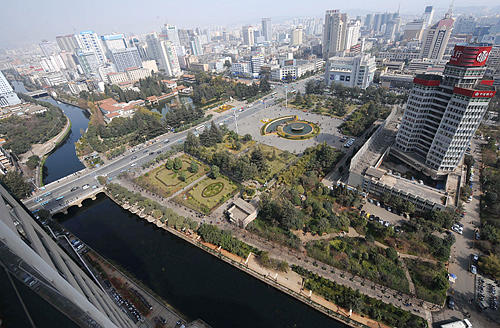|
 |
|
FROM RESOLUTION TO ACTION: Pictured is the harnessed Panlong River, a major river that leads to Dianchi Lake, Yunnan Province. In recent years, the western region has strengthened efforts in environment protection (QIN QING) |
The center of China's economic growth is gradually shifting west. In the next few decades, China's western region will be more attractive to investors than the eastern region, and the west will offer more investment opportunities, said Chen Wei, a researcher with China Minzu Securities Co. Ltd.
In the first half of this year, economic growth in the western region was best described as a "locomotive" that drove the rest of the country's economic growth. Figures from the National Bureau of Statistics show China's east coastal region's GDP growth rates became sluggish, all lower than 10 percent, while the country's west has maintained double-digit growth at an average of 13 percent. Inner Mongolia, the star of the western region, achieved economic growth of 16.5 percent, much higher than the national average of 9.6 percent.
"The economic status of the western region is expected to increase," said Yao Huiqin, Executive Deputy Director of the Research Center of West China's Economic Development at the Northwest University in Xi'an, Shaanxi Province. Yao's team, in cooperation with the Chinese Academy of Social Sciences (CASS), released the Annual Report on Economic Development in the Western Region of China (2011) on July 24. The report says, the west's economic growth rate will continue to drive national economic growth.
As the western region records astonishing economic progress, questions are being asked if the eastern coastal region has depleted its competitive advantages and if the future of China's economic growth will rely solely on the western region.
New growth point
To develop the economy in line with the reform and opening-up policy launched in the late 1970s, the Central Government proposed to develop the east coastal region first. In 1984, the government designated 14 cities in the east, including Dalian, Tianjin, Shanghai, Wenzhou and Guangzhou, as open coastal cities, offering favorable policies different from inland cities in order to attract foreign investment.
This policy has proven to be the right choice as made apparent by the economic growth in the following 30 years. Three economic belts around the Bohai Sea, the Yangtze River Delta and the Pearl River Delta have been formed as the core to promote the nation's sustained and rapid economic growth. In 2008, the GDP in the eastern region accounted for 54.3 percent of the national total, up 10.9 percentage points since 1978.
During the development phase in the past three decades, many eastern cities have developed rapidly, such as Tianjin, Shanghai, Guangzhou and Shenzhen, bringing about great social changes.
With the east's rapid development, the central and western regions fell behind and the regional economic disparity has grown. Large numbers of migrant workers swarmed into east coastal areas looking for jobs in the newly prosperous region. The wide gap between the rich and the poor has also led to disparities in education, health care, housing and other aspects, causing more social conflicts.
Since the 1990s, the Chinese Government took steps to assuage these problems, mainly by implementing the western development strategy, by revitalizing the traditional industrial bases in northeast China and by promoting investment in the central region. These policies have boosted the development of central and western regions, raising their major economic indicators to approach to those of the eastern region.
CASS figures show, from 2006 to 2010 the economic growth rate in the western region was higher than the national average. In the past five years, the average growth of the GDP in the western region was 13.9 percent, which was 0.9 percentage points higher than the national average.
"The western region has witnessed steady and fast economic growth with less fluctuations and smaller potential risks in economic operations," said the annual economic development report.
Just as the western region develops rapidly, the eastern area has been mired in turmoil following the global financial crisis in 2008.
Since the eastern region has adopted an economic growth pattern reliant on exporting primarily processed products, the technological level of the products is low and most of the industries are labor-intensive. Low product price is the major weapon for making profits. Once the manufacturing costs, such as labor and raw materials, increase, the economy in the eastern region will take a hit.
After the global financial crisis broke out, China's exports decreased drastically. To cope with the crisis, the United States adopted a quantitative easing policy and China launched a 4-trillion-yuan ($586-billion) stimulus package. These practices have led to a serious excess of money in international and domestic markets. The accelerated inflation has not only driven price hikes of raw materials, but also increased labor costs. In addition, the eastern region has suffered shortages of labor, electricity and land in recent years.
For these reasons, GDP in the eastern region slowed and even declined in 2009. From the first half of 2009, GDP growth rates in the western region began to surpass those of the eastern region.
| 